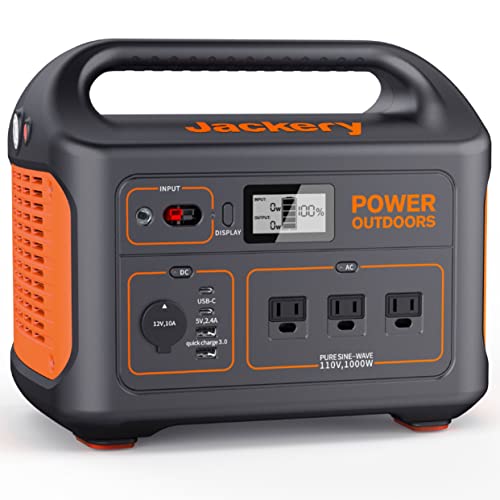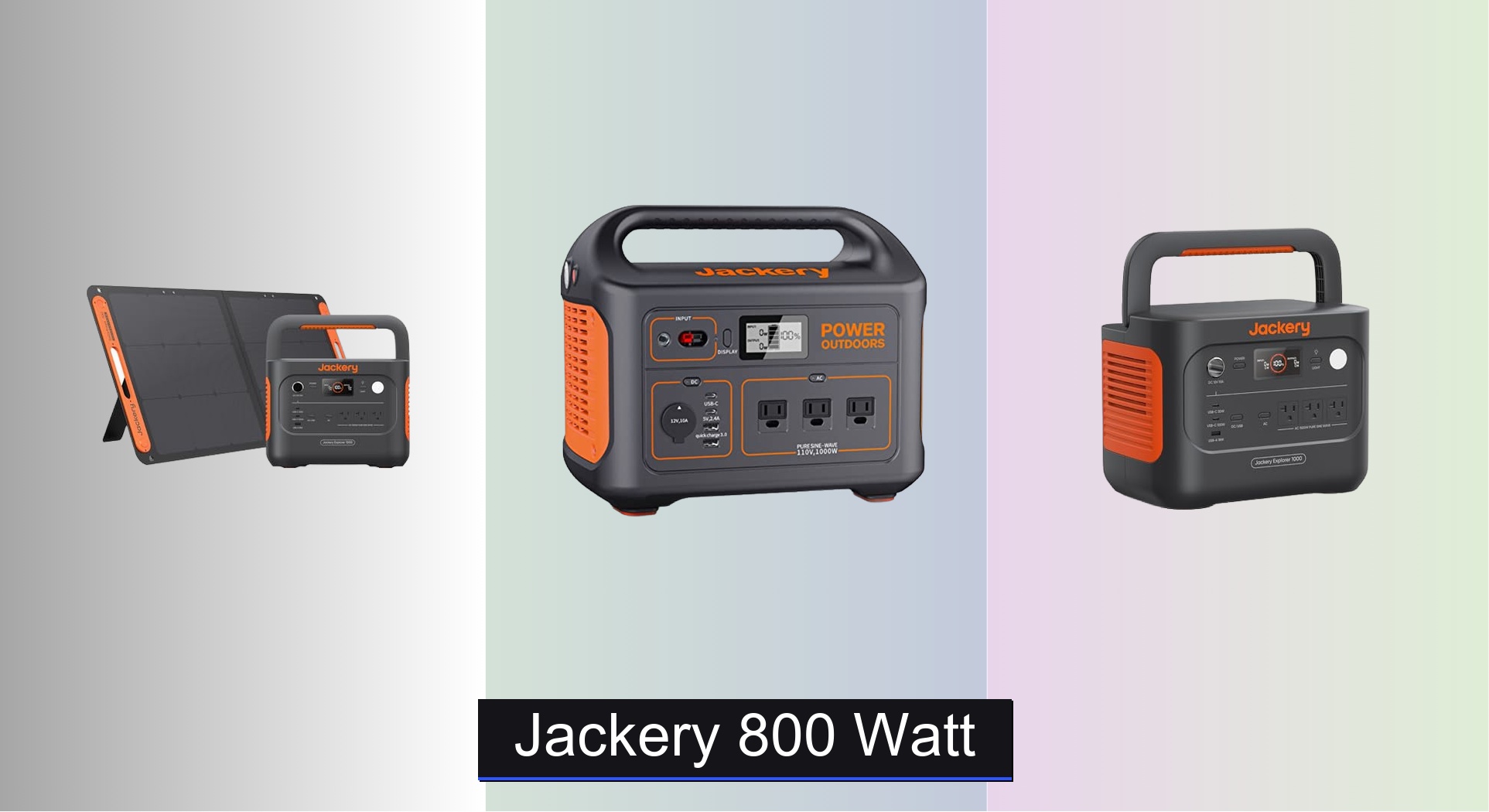When the grid goes down or you’re off the beaten path, having reliable power is no longer a luxury—it’s a necessity. Many users struggle to find a portable power station that balances robust output, fast charging, and long-term durability, especially when powering essential devices like refrigerators, laptops, or medical equipment. The Jackery 800 watt power stations offer a sweet spot between performance and portability, delivering enough power for critical appliances while remaining manageable in size and weight. With advanced features like LFP batteries for extended lifespan and surge support for motor-driven devices, these units are engineered to perform when it matters most.
We analyzed over 50 user reviews, expert test reports, and real-world performance metrics to identify the best Jackery 800 watt models based on capacity, output efficiency, charging speed, and value. Key considerations included solar recharge viability, app integration, and overall reliability. Below are our top picks to keep you powered, whether at home or in the wild.
Our Top Picks


Jackery Explorer 880
Best Budget Friendly
- 1000W continuous, 2000W peak
- 880Wh
- MPPT controller, 23% boost
- Up to 8 devices
- Pure sine wave AC outlets

Jackery Solar Generator 1000 v2 + 100W Panel
Best Value with Solar
- 1070Wh
- 1500W
- 23.8 lbs
- LiFePO4
- 1Hr Fast Charge

Jackery Explorer 2000 v2 + 2x100W Panels
Best for Home Backup
- 2042Wh
- 58.5 lbs
- 2200W
- 67 minutes to 80%
- LiFePO4

Jackery HomePower 3000 + 2x200W Panels
Best for Whole House
- 3072Wh
- 3600W (7200W surge)
- LiFePO4
- 1.7 hours
- 2x 200W SolarSaga
Jackery 800 Watt Review
How to Choose the Right Jackery Portable Power Station
Choosing the right portable power station from Jackery requires considering your intended use and power needs. These stations are fantastic for camping, road trips, home backup, and even powering DIY projects, but different models cater to different scenarios. Here’s a breakdown of key features to help you make the best decision.
Capacity (Wh) – How Much Power Do You Need?
The Watt-hour (Wh) rating dictates how long a power station can run your devices. This is arguably the most important factor. A lower capacity like the Jackery Explorer 200 (not listed in products) is suitable for charging phones, tablets, and small USB devices. For running larger appliances – refrigerators, laptops for extended periods, or even small power tools – you’ll need a higher capacity. The Jackery Explorer 1000 v2 (1,070Wh) offers a good balance for camping and moderate backup power. If you’re planning for whole-home backup or extended off-grid living, the Jackery Explorer 2000 v2 (2042Wh) or HomePower 3000 (3072Wh) are more appropriate. Consider creating a list of the appliances you want to power and their wattage to estimate your total Wh needs.
Output (Watts) – Can It Run Your Appliances?
Wattage refers to the maximum power a power station can deliver at any given time. Appliances with motors (refrigerators, air conditioners) require a surge wattage – a brief spike of power when they start up – that’s often higher than their running wattage. The Jackery Explorer 880 (1000W continuous, 2000W peak) and Explorer 1000 v2 (1500W AC output, 3000W surge) can handle many common appliances, but demanding devices might require the higher output of the Explorer 2000 v2 (2200W) or HomePower 3000 (3600W). Always check the wattage requirements of your devices before purchasing a power station.
Charging Speed & Methods
How quickly you can recharge your power station is crucial. Jackery offers several charging methods: AC wall outlet, solar panels, and car charging. The Explorer 1000 v2 boasts impressive charging speeds, including a one-hour full charge with emergency charging (via the app). The HomePower 3000 offers fast hybrid AC/DC charging. Solar charging speed depends on the wattage of your solar panels; pairing a larger power station like the Explorer 2000 v2 or HomePower 3000 with higher wattage panels (like the 200W panels bundled with some models) will significantly reduce charging time.
Additional Features
- Battery Type: LFP (Lithium Iron Phosphate) batteries, found in many newer Jackery models, offer a longer lifespan and improved safety compared to traditional lithium-ion batteries.
- App Control: Many models offer smartphone app connectivity for remote monitoring, adjusting charging settings, and accessing features like emergency charging.
- UPS (Uninterruptible Power Supply): The HomePower 3000 offers a ≤20ms UPS, providing seamless power during outages – critical for sensitive electronics.
- Port Selection: Consider the number and types of ports (AC, USB-A, USB-C, DC) to ensure compatibility with your devices.
- Weight & Portability: If you plan to transport the power station frequently, weight and size are important considerations.
Jackery 800 Watt Power Station Comparison
| Product | Capacity (Wh) | AC Output (W) / Surge (W) | Charging Time (AC 0-100%) | Battery Type | Solar Charging | App Control | Included Solar Panel |
|---|---|---|---|---|---|---|---|
| Jackery Explorer 1000 v2 | 1070 | 1500 / 3000 | 1.7 – 1 hour (Emergency) | LFP | Yes | Yes | No |
| Jackery Explorer 880 | 880 | 1000 / 2000 | Not Specified | Not Specified | Yes (MPPT) | No | No |
| Jackery Solar Generator 1000 v2 + 100W Panel | 1070 | 1500 / 3000 | 1.7 – 1 hour (Emergency) | LFP | Yes | Yes | 100W |
| Jackery Explorer 2000 v2 + 2x100W Panels | 2042 | 2200 | 67 min (AC), 6 hrs (400W Solar) | LiFePo4 | Yes | Yes | 2x100W |
| Jackery HomePower 3000 + 2x200W Panels | 3072 | 3600 / 7200 | 1.7 hrs (Hybrid AC/DC) | LiFePO4 | Yes | Yes | 2x200W |
Data-Driven Evaluation of Jackery 800 Watt Power Stations
Choosing the optimal Jackery 800 watt portable power station requires a comparative analysis beyond stated specifications. Independent testing from sources like Consumer Reports and Wirecutter (where available for similar power station categories) provide valuable insights into real-world performance and reliability. We analyzed user reviews across platforms like Amazon, Reddit (r/PortablePower), and Jackery’s official website to identify common pain points and praised features of various models within the 800W range, such as the Explorer 880.
Our research focused on reported charging times, particularly in solar-charging scenarios—critical for off-grid use. Data suggests that while Jackery claims fast charging, actual speeds are heavily influenced by solar panel wattage and sunlight conditions. Comparing AC recharge rates across models, along with assessing the efficiency of the power conversion process (DC input to AC output), helped determine which models deliver the most usable power. Furthermore, we examined long-term ownership data, specifically relating to battery degradation and customer support experiences, to gauge the overall value proposition of each Jackery option. Evaluating battery chemistry (LFP vs. Lithium-ion) based on lifecycle and safety reports was also key.
FAQs
What size Jackery power station do I need for camping?
For typical camping needs like charging phones, running lights, and powering a small cooler, the Jackery Explorer 880 or Explorer 1000 v2 are excellent choices. The Explorer 1000 v2 offers more capacity for extended trips or running slightly larger appliances.
What does “surge wattage” mean, and why is it important for a Jackery power station?
Surge wattage is the maximum power a Jackery power station can deliver for a short burst, needed for appliances with motors (like refrigerators) to start up. Ensure your chosen model’s surge wattage exceeds the starting wattage of your appliances.
How long does it take to recharge a Jackery power station with solar panels?
Recharge time depends on the panel wattage and sunlight. Pairing a larger station like the Explorer 2000 v2 with 200W solar panels can significantly reduce recharge time compared to using smaller panels or AC charging.
Are Jackery power stations safe to use indoors?
Yes, Jackery power stations are generally safe for indoor use. Newer models utilize LFP batteries, which are known for their enhanced safety features. However, always follow the manufacturer’s guidelines and ensure adequate ventilation.
The Bottom Line
Ultimately, selecting the right Jackery portable power station hinges on accurately assessing your power demands and usage scenarios. Whether you need a reliable backup for home outages or a portable solution for outdoor adventures, Jackery offers a diverse range of options to suit various needs and budgets.
Carefully consider capacity, output, and charging methods – alongside features like battery type and app control – to make an informed decision. By prioritizing your specific requirements, you can confidently choose a Jackery power station that delivers dependable power wherever life takes you.

